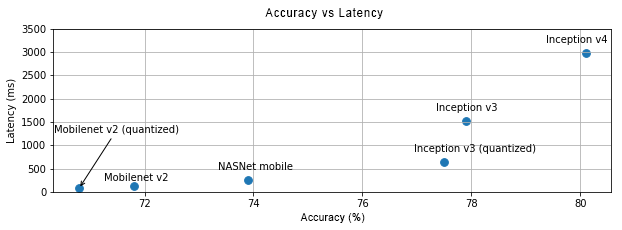Mobile and embedded devices have limited computational resources, so it is important to keep your application resource efficient. We have compiled a list of best practices and strategies that you can use to improve your TensorFlow Lite model performance.
Choose the best model for the task
Depending on the task, you will need to make a tradeoff between model complexity and size. If your task requires high accuracy, then you may need a large and complex model. For tasks that require less precision, it is better to use a smaller model because they not only use less disk space and memory, but they are also generally faster and more energy efficient. For example, graphs below show accuracy and latency tradeoffs for some common image classification models.


One example of models optimized for mobile devices are MobileNets, which are optimized for mobile vision applications. TensorFlow Hub lists several other models that have been optimized specifically for mobile and embedded devices.
You can retrain the listed models on your own dataset by using transfer learning. Check out the transfer learning tutorials using TensorFlow Lite Model Maker.
Profile your model
Once you have selected a candidate model that is right for your task, it is a good practice to profile and benchmark your model. TensorFlow Lite benchmarking tool has a built-in profiler that shows per operator profiling statistics. This can help in understanding performance bottlenecks and which operators dominate the computation time.
You can also use TensorFlow Lite tracing to profile the model in your Android application, using standard Android system tracing, and to visualize the operator invocations by time with GUI based profiling tools.
Profile and optimize operators in the graph
If a particular operator appears frequently in the model and, based on profiling, you find that the operator consumes the most amount of time, you can look into optimizing that operator. This scenario should be rare as TensorFlow Lite has optimized versions for most operators. However, you may be able to write a faster version of a custom op if you know the constraints in which the operator is executed. Check out the custom operators guide.
Optimize your model
Model optimization aims to create smaller models that are generally faster and more energy efficient, so that they can be deployed on mobile devices. TensorFlow Lite supports multiple optimization techniques, such as quantization.
Check out the model optimization docs for details.
Tweak the number of threads
TensorFlow Lite supports multi-threaded kernels for many operators. You can increase the number of threads and speed up execution of operators. Increasing the number of threads will, however, make your model use more resources and power.
For some applications, latency may be more important than energy efficiency. You can increase the number of threads by setting the number of interpreter threads. Multi-threaded execution, however, comes at the cost of increased performance variability depending on what else is executed concurrently. This is particularly the case for mobile apps. For example, isolated tests may show 2x speed-up vs single-threaded, but, if another app is executing at the same time, it may result in worse performance than single-threaded.
Eliminate redundant copies
If your application is not carefully designed, there can be redundant copies
when feeding the input to and reading the output from the model. Make sure to
eliminate redundant copies. If you are using higher level APIs, like Java, make
sure to carefully check the documentation for performance caveats. For example,
the Java API is a lot faster if ByteBuffers are used as
inputs.
Profile your application with platform specific tools
Platform specific tools like Android profiler and Instruments provide a wealth of profiling information that can be used to debug your app. Sometimes the performance bug may be not in the model but in parts of application code that interact with the model. Make sure to familiarize yourself with platform specific profiling tools and best practices for your platform.
Evaluate whether your model benefits from using hardware accelerators available on the device
TensorFlow Lite has added new ways to accelerate models with faster hardware like GPUs, DSPs, and neural accelerators. Typically, these accelerators are exposed through delegate submodules that take over parts of the interpreter execution. TensorFlow Lite can use delegates by:
- Using Android's Neural Networks API. You can utilize these hardware accelerator backends to improve the speed and efficiency of your model. To enable the Neural Networks API, check out the NNAPI delegate guide.
- GPU delegate is available on Android and iOS, using OpenGL/OpenCL and Metal, respectively. To try them out, see the GPU delegate tutorial and documentation.
- Hexagon delegate is available on Android. It leverages the Qualcomm Hexagon DSP if it is available on the device. See the Hexagon delegate tutorial for more information.
- It is possible to create your own delegate if you have access to non-standard hardware. See TensorFlow Lite delegates for more information.
Be aware that some accelerators work better for different types of models. Some delegates only support float models or models optimized in a specific way. It is important to benchmark each delegate to see if it is a good choice for your application. For example, if you have a very small model, it may not be worth delegating the model to either the NN API or the GPU. Conversely, accelerators are a great choice for large models that have high arithmetic intensity.
Need more help
The TensorFlow team is happy to help diagnose and address specific performance issues you may be facing. Please file an issue on GitHub with details of the issue.
